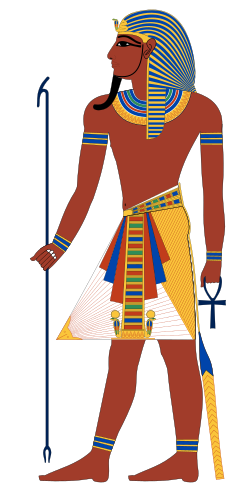16. dynastie
16. dynastie
| |||||||||
Geografie
| |||||||||
| Obyvatelstvo | |||||||||
| Státní útvar | |||||||||
| Státní útvary a území | |||||||||
| |||||||||
16. dynastie byla jednou ze staroegyptských královských dynastií řazených egyptology do historického období Druhé přechodné doby. Tato dynastie vládla Hornímu Egyptu po dobu sedmdesáti let v období ~1650–1580 př. n. l.[1] Panovníci 16. dynastie, jejichž sídlo bylo v Thébách, vládli souběžně s hyksóskou 15. dynastií, která ovládala sever země z hlavního města Avaris.
Historický vývoj






Thébští králové spravovali Horní Egypt přibližně od hranic s Nubií u ostrova Elefantina a 1. kataraktu až po střední Egypt poblíž města Abydos, kde se v období 1600–1650 př. n. l. uvádí Abydosská dynastie. Ta pravděpodobně vznikla v období dobývání Memfis Hyxosy a jejich postupem na jih a ustavení vlády v Thébách.[1][2]. Historie dynastie v Abydosu je datována do období 1650–1600 př. n. l. Théby i Abydos byli vazalové centrální vlády v Avaris. Hodnověrná údaje o této době chybí, nachází se pouze zlomky, ze kterých spíše vyplývají chaotické děje.[3]
Panovníci v Thébách
| Král | rodné jméno | trůní jména | období př. n. l.[1] | ||||||||||||||||||||||||||
|---|---|---|---|---|---|---|---|---|---|---|---|---|---|---|---|---|---|---|---|---|---|---|---|---|---|---|---|---|---|
| Dyehuti | Ra je ten mocný, který ochraňuje obě země | 1649–1648 | |||||||||||||||||||||||||||
| Sebekhotep VIII. |
| 1645–1629 | |||||||||||||||||||||||||||
| Neferhotep III | ~1629 | ||||||||||||||||||||||||||||
| Mentuhotepi | 1628–1627 | ||||||||||||||||||||||||||||
| Nebirau I. | 1627–1601 | ||||||||||||||||||||||||||||
| Nebirau II | ~1601 | ||||||||||||||||||||||||||||
| Bebiankh | 1600–1588 | ||||||||||||||||||||||||||||
| Dedumose I. | |||||||||||||||||||||||||||||
| Dedumose II. | |||||||||||||||||||||||||||||
| Mentuensaf | |||||||||||||||||||||||||||||
| Mentuhotep VI. | |||||||||||||||||||||||||||||
| Senusret IV. |
|
16. dynastie v Thébách měla pokračování v 17. dynastii, v poslední fázi Druhé přechodné doby a znovuobnovení jednoty nástupem egyptské 18. dynastie. [5] Příklady: [6]
Panovníci v Abydosu
Identifikovaní panovníci v Abydosu jsou uváděni v krátkém období jejich působení 1650–1600 př. n. l.
| Král | rodné jméno | trůní jména[1] | ||||||||||||||||||||||||||||
|---|---|---|---|---|---|---|---|---|---|---|---|---|---|---|---|---|---|---|---|---|---|---|---|---|---|---|---|---|---|---|
| Upuautemsaf Sejemra Neferjau Upuautemsaf | ||||||||||||||||||||||||||||||
| Pantyeny Sejemra Jutauy Pantyeny | ||||||||||||||||||||||||||||||
| Senaib Menjaura Senaib | ||||||||||||||||||||||||||||||
| Senebkay Useribra Senebkay |
Vláda králů v Abydosu, která byla územně a chronologicky redukovaná, na dobu mezi roky ~1650–1600 postupně splynula s Thébskou dynastií v době vlády krále Bebiankha. Jeho aktivity jsou zaznamenány na stéle nalezené v Gebal Zeit [p 2] kde se nacházelo naleziště Galenitu sulfidu olovnatého. Několik staveb je uváděno i v nekropoli v Abydosu.[7]
Poznámky
Reference
- ↑ a b c d BOURRIAU, Janine. The Second Intermediate Period (c.1650-1550 BC) [online]. New York: Oxford University Press, 2000. S. 172–206. Dostupné online. ISBN 978-0-19-280458-7. (anglicky)
- ↑ RYHOLT, Kim. The Political Situation in Egypt during the Second Intermediate Period B.c. 1800-1550 B.C. [online]. Copenhagen: Museum Tusculanum Press, 1997. Dostupné online.
- ↑ POLZ, Daniel. Die Hyksos -Blöcke aus Gebelin: zur Präsenz der Hyksos in berägzpten. Leuven: Orientalia Lovaniensia Analecta, 2006. S. 239-247.
- ↑ The Sixteenth Dynasty [online]. Dostupné online. (anglicky)
- ↑ ILIN-TOMICH, Alexander. Second Intermediate Period [online]. Los Angelese: UCLA Encyclopedia of Egyptology, 2016. S. 9-. Dostupné online. (anglicky)
- ↑ MARÉE, Marcel. The Second intermediate period (thirteenth-seventeenth dynasties) : current research, future prospects. Leuven: Walpole, MA : Peeters, 2010.
- ↑ CASTEL, Georg. Dépôt de stèles dans le sanctuaire du Nouvel Empire au Gebel [online]. BIFAO 85, 1985. S. 285–293. Dostupné online. (francouzsky)
Literatura
- Jürgen von Beckerath: Handbuch der ägyptischen Königsnamen, Münchner ägyptologische Studien, Heft 49, Mainz : P. von Zabern, 1999, SBN 3-8053-2591-6
- Chris Bennet, A Genealogical Chronology of the Seventeenth Dynasty, Journal of the American Research Center in Egypt, Vol. 39 (2002), pp. 123–155
- K.S.B. Ryholt, The Political Situation in Egypt during the Second Intermediate Period c. 1800–1550 B.C. Carsten Niebuhr Institute Publications 20. Copenhagen
- K. Ryholt, "The Turin King-List", Ägypten und Levante 14, 2004, pp. 135–155
- Daphna Ben-Tor:Sequence and chronology of second inetermediate royal-name scarabs based on excavated series from Egypt and the Levant, in: Marcel Marée, The second intermediat period, Leuven 2010
Externí odkazy
 Obrázky, zvuky či videa k tématu 16. dynastie na Wikimedia Commons
Obrázky, zvuky či videa k tématu 16. dynastie na Wikimedia Commons
Média použitá na této stránce
Autor: Jeff Dahl, Licence: CC BY-SA 4.0
The double crown symbolizing dominion over upper and lower Egypt.
Autor: Jeff Dahl, Licence: CC BY-SA 4.0
Typical ancient Egyptian crook and flail. It symbolizes leadership and a powerful ruler
Autor: Jeff Dahl, Licence: CC BY-SA 4.0
Pharaoh, the king of ancient Egypt, is often depicted wearing the nemes headdress and an ornate shendyt. Based on New Kingdom tomb paintings.
Drawing of a limestone stele depicting prince Djehuti-Aa and princess Hotepneferu. At the top, the cartouches of pharaoh (Sekhemre-khutawy Pantjeny). From Abydos. British Museum 282 (registr. no. 630).
Autor: Juan R. Lazaro, Licence: CC BY 2.0
Statue of king Meriankhre Mentuhotep, known as Mentuhotep VI or Mentuhotep V depending on the scholar, late 16th dynasty, London, British Museum EA 65429.
Autor: Enyavar, Licence: CC BY-SA 4.0
Ancient Orient around 1600 BCE:
- Hyksos in Upper Egypt
- Old Hittite Empire invades Babylon
Autor: Ernesto Graf, Licence: CC BY-SA 3.0
Mapa del estado de Egipto durante mediados del Segundo Período Intermedio (dinastía XVI).
Autor: Internet Archive Book Images, Licence: No restrictions
Identifier: egyptsdnhand00karl (find matches)
Title: Egypt and the Sûdân; handbook for travellers
Year: 1914 (1910s)
Authors: Karl Baedeker (Firm)
Subjects: Egypt -- Guidebooks Sudan -- Guidebooks
Publisher: Leipzig : K. Baedeker New York, C. Scribner's sons (etc., etc.)
Contributing Library: University of California Libraries
Digitizing Sponsor: MSN
View Book Page: Book Viewer
About This Book: Catalog Entry
View All Images: All Images From Book
Click here to view book online to see this illustration in context in a browseable online version of this book.
Text Appearing Before Image:
still occupied by modern huts. The Second Court, whicb opens to the S. on the temple proper,is in better preservation. The sons and daughters of Ramses II.were represented oti the wall on the inner side of the pylon, butthe figures and inscriptions have been almost effaced. On the rightand left walls appears Ramses II., sacrificing to different gods; oneach side are steles of Ramses II. At the back of the court alow incline ascends to the vestibule of the temple proper, whichis supported by 12 square piers of limestone and originally hadseven doors in its rear wall. On the wall, to the left of the mainentrance, is a Large Inscription in 95 vertical lines, in whichRamses II. describes in florid language the completion of the temple.In the adjoining relief Ramses is shown presenting an image of thegoddess Maat to a triad consisting of Osiris, Isis, and his fatherSethos I., who takes the place of Horus. On the wall are otherrepresentations of Ramses in presence of the gods. — The seven
Text Appearing After Image:
'
Note About Images
Autor: Khruner, Licence: CC BY-SA 4.0
Drawing of the upper part of an ancient Egyptian dagger bearing the name of pharaoh Bebiankh (the pommel is missing). Bronze from Naqada, reign of Bebiankh, 16th Dynasty, Second Intermediate Period. British Museum EA66062.
Autor: Wallis Budge (1857-1934), Licence: CC BY-SA 3.0
Drawing of the stele of Wepwawetemsaf, possibly a king of the Abydos Dynasty or of the late 16th Dynasty, during the second intermediate period. British Museum 281 (registr. no. 969). Made in 1913 by Wallis Budge.










